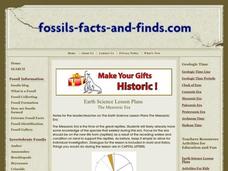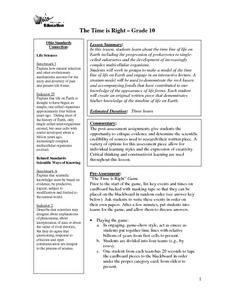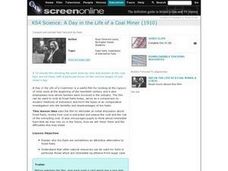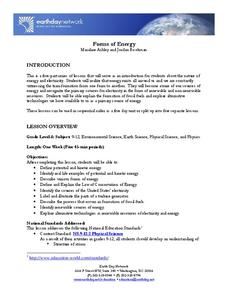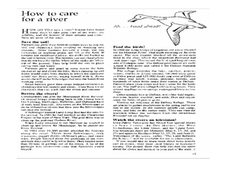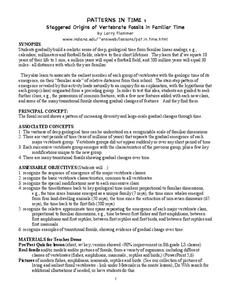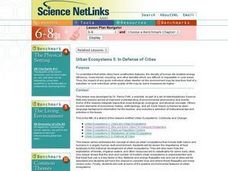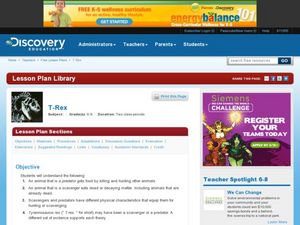Virginia Department of Education
Three Types of Rocks
Rock out with the second installment of a five-part series on earth materials and processes. Your budding geologists make observations of given rock samples and posit classification systems for rocks. They then learn about the...
Curated OER
Math in Science-Radioactive Decay and Half-Life
For this radioactive decay and half-life worksheet, students use given half-lifes to calculate the amount of time it will take for certain amounts of elements to decay. They also find the age of samples and determine how many grams of...
Curated OER
Roots: The Ancestry of Modern People
High schoolers investigate the models for the origin of modern humans and the conditions that facilitate speciation and evolution. The classification and nomenclature of hominid species is also examined.
Curated OER
Do You See What I See?
Young scholars engage in a lesson that differentiates between right and wrong types of observations. In order to conduct the experiment they are provided with leaves and nameless objects with different designs. The two are compared and...
US Environmental Protection Agency
Carbon Through the Seasons
Meteorologists view an animated video by the Environmental Protection Agency to learn how the carbon cycle works, and then move into groups to analyze and graph actual data of the atmospheric carbon dioxide concentration from Hawaii's...
Curated OER
The Mesozoic Era
Sixth graders recognize that the Earth was different in different eras. In this Mesozoic Era lesson, 6th graders compare the time frame of the different eras and how long they lasted for by graphing them. Students study the...
Curated OER
The Achaean
Fourth graders study the characteristics of the Achaean era. In this Achaean era lesson, 4th graders examine the clock of eras and compare the characteristics of different eras. They determine that the rocks associated with this era can...
Curated OER
The Time is Right
Tenth graders study the timeline of life on Earth. They learn about the progression of prokaryotes to single celled eukaryotes and the development of increasingly complex multicellular organisms.
Curated OER
Fossils
First graders write a brief informational description of a real life object, person, place or event using information gained from observations. They create their own fossil imprints and write a brief description about the fossil that...
Curated OER
A Day in the Life of a Coal Miner (1910)
Students compare and contrast fossil fuels and bio-fuels. They brainstorm what mining might look like in the future. Students view the film "A Day in the Life of a Coalminer." They discuss fossil fuels and the methods of extraction....
Earth Day Network
Forms of Energy
Give me a home where electric buffalo roam and I'll show you an ohm on the range. Introduction your classes to potential and kinetic energy, electricity, and renewable resources with a resource that combines observation, direct...
Curated OER
The Delicate Balance - Iowa's Natural Resources
Discover the natural resources in Iowa by studying it's history. For this environmental lesson, your students will observe a topographical map of Iowa and identify where its most valuable resources are. They complete an Iowa name...
Curated OER
Physiological Adaptations
Students investigate the concepts of genetics and how it is tied to the variations found within different species and how it is tied to adaptations. They review the theory of evolution and factors found to help create variation. The...
Curated OER
PATTERNS IN TIME
Students build a realistic sense of geological time, seek clues of transition fossils and find them. In this investigative lesson students complete several activities and worksheets on fossils.
Curated OER
Patterns In Time
Seventh graders examine fossils. In this vertebrate fossils lesson students view a demonstration.
Curated OER
Urban Ecosystems 5: In Defense Of Cities
Students explain that while cities have unattractive features, the density of human life enables energy efficiency, mass transit, recycling, and other benefits which are difficult or impossible in rural areas. This is the fifth in an...
Curated OER
The Mystery Box
Students design a mystery box to hold an object related to the timeline of life studies. In this timeline of life lesson, student play a game with fossils and other remnants of past times and guess the era it comes from.
Curated OER
Dinosaur Detectives
Students write a report about a paleontologist. In this paleontology lesson plan, students research and write a report about a noted paleontologist. They discuss the importance of technology to paleontologists and how paleontologist...
Curated OER
How Old Is Mike?
Students examine the absolute dating of fossils, they use a list of names and ages to determine the difference between relative age and absolute age. They explore the relative age and absolute age of people and of fossils.
Curated OER
The Rise and Fall of the Mammoths
Students develop an understanding of the evolution of species in the context of the woolly mammoth. They examine the fossil record to explain natural selection.
Curated OER
Climate Change: Is there a Controversy
Students explore climate changes. In this climate changes lesson, students research what causes changes. Students search the Internet, summarize reports they find and create a poster with the information.
Curated OER
T-Rex
Young scholars examine the differences between a scavenger and a predator. In this predator activity students research an animal and study its physical traits.
Curated OER
Grand Canyon History Lesson
Students explore the history of the Grand Canyon. In this Grand Canyon lesson plan, students read "Grand Canyon National Park" by David Peterson and respond to questions regarding the piece. Students also create their own fossil models...
Curated OER
Tiktaalik: Evolution of a "Fishapod"
Young scholars explore fossils in order to gain a perspective of evolution. For this evolution lesson students watch several videos an fossils and complete a worksheet.







